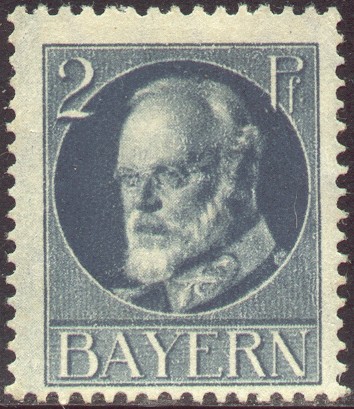
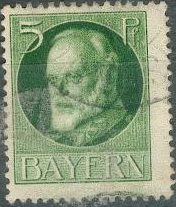
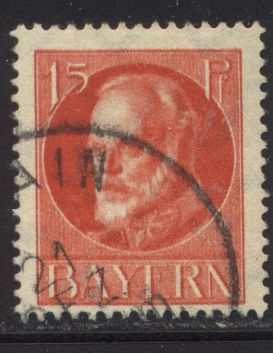
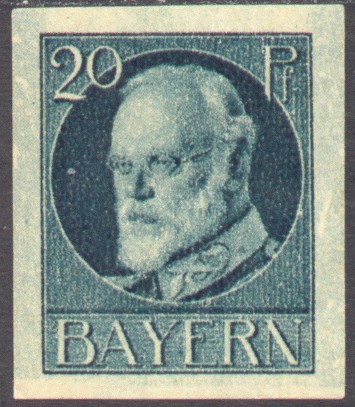
Return To Catalogue - Bavaria overview - Other German States - Germany
Note: on my website many of the
pictures can not be seen! They are of course present in the cd's;
contact me if you want to purchase them: evert@klaseboer.com.
For stamps of Bavaria issued from 1876 to 1913, click here.
Note: imperforated stamps exists of this issue (and the overprints) and were mainly made for stamp collectors.
2 p grey 3 p brown 5 p green 7 1/2 p green 10 p red 15 p red 20 p blue 25 p black 30 p orange 40 p olive 50 p brown 60 p green 80 p violet Larger size
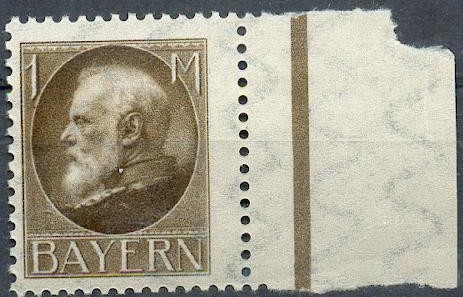
(Note the watermark 'vertical wavy lines')
1 M brown 2 M violet 3 M red Very large size
5 M blue 10 M green 20 M brown Surcharged
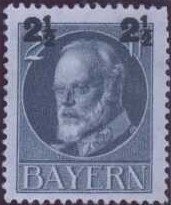
'2 1/2' on 2 p grey Imperforated The values 3,20,25,30,40,50,60 and 80 p exist imperforated.
Specialist distinghuish between the first very nicely printings (Friedensausgabe or peace issue) and later deterioating printings (Kriegsausgabe or war issue). All stamps have watermark 'horizontal wavy lines', except 1 M, 2 M and 3 M which have watermark 'vertical wavy lines'. The stamps are perforated 14 x 14 1/2 (if perforated of course).
Value of the stamps |
|||
vc = very common c = common * = not so common ** = uncommon |
*** = very uncommon R = rare RR = very rare RRR = extremely rare |
||
| Value | Unused | Used | Remarks |
| 2 p | c | c | 1918 |
| 3 p | vc | vc | |
| 5 p | vc | vc | Shades of green |
| 7 1/2 p | vc | vc | 1916 |
| 10 p | vc | vc | Shades of red |
| 15 p | vc | vc | 1916, Shades of red |
| 20 p | vc | vc | |
| 25 p | vc | vc | |
| 30 p | vc | vc | |
| 40 p | vc | vc | |
| 50 p | vc | vc | |
| 60 p | vc | vc | |
| 80 p | vc | vc | |
| 1 M | vc | vc | |
| 2 M | c | c | |
| 3 M | c | c | |
| 5 M | c | c | |
| 10 M | * | * | |
| 20 M | * | * | |
| 2 1/2 on 2 p | vc | vc | 1916 |
Overprinted 'VOLKSSTAAT BAYERN', (all these values exist imperforated)
3 p brown 5 p green 7 1/2 p green 10 p red 15 p red 20 p blue 25 p black 30 p orange 35 p orange 40 p olive 50 p brown 60 p green 75 p brown 80 p violet Larger size
1 M brown 2 M violet 3 M red Very large size
5 M blue 10 M green 20 M brown
Value of the stamps |
|||
vc = very common c = common * = not so common ** = uncommon |
*** = very uncommon R = rare RR = very rare RRR = extremely rare |
||
| Value | Unused | Used | Remarks |
| 3 p to 50 p | vc | vc | 35 p exists without overprint |
| 60 p | c | c | |
| 75 p | vc | vc | |
| 80 p | c | vc | |
| 1 M | c | vc | |
| 2 M | c | vc | |
| 3 M | c | c | |
| 5 M | c | c | |
| 10 M | * | * | |
| 20 M | * | * | |
Overprinted 'FREISTAAT BAYERN' (all these values exist imperforated)
3 p brown 5 p green 7 1/2 p green 10 p red 15 p red 20 p blue 25 p black 30 p orange 40 p olive 50 p brown 60 p green 75 p brown 80 p violet Larger size
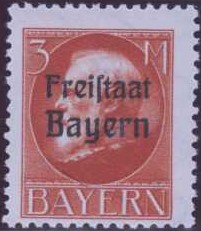
1 M brown 2 M violet 3 M red Very large size
5 M blue 10 M green 20 M brown
Value of the stamps |
|||
vc = very common c = common * = not so common ** = uncommon |
*** = very uncommon R = rare RR = very rare RRR = extremely rare |
||
| Value | Unused | Used | Remarks |
| 3 p to 30 p | vc | vc | |
| 40 p | c | c | |
| 50 p | vc | vc | |
| 60 p | c | c | |
| 75 p | c | c | |
| 80 p | c | c | |
| 1 M | c | c | |
| 2 M | c | c | |
| 3 M | c | c | |
| 5 M | * | * | |
| 10 M | * | * | |
| 20 M | * | * | |
Overprinted '5 Pf fur kriegsbeschadigte FREISTAAT BAYERN'
10 + 5 p red 15 + 5 p red 20 + 5 p blue
Value of the stamps |
|||
vc = very common c = common * = not so common ** = uncommon |
*** = very uncommon R = rare RR = very rare RRR = extremely rare |
||
| Value | Unused | Used | Remarks |
| 10 + 5 p | vc | vc | |
| 15 + 5 p | vc | vc | |
| 20 + 5 p | vc | vc | |
Overprinted 'Freistaat Bayern' and surcharged (all these stamps exist imperforated)
'1,25 M' on 1 M green '1,50 M' on 1 M orange '2,50 M' on 1 M grey
Value of the stamps |
|||
vc = very common c = common * = not so common ** = uncommon |
*** = very uncommon R = rare RR = very rare RRR = extremely rare |
||
| Value | Unused | Used | Remarks |
| 1,25 M on 1 M | c | c | |
| 1,50 M on 1 M | c | c | Exists without overprint |
| 2,50 M on 1 M | c | c | Exists without overprint |
Perforated with 'E' to serve as railway stamps (1914)
3 p brown 5 p green 10 p red 20 p blue
Value of the stamps |
|||
vc = very common c = common * = not so common ** = uncommon |
*** = very uncommon R = rare RR = very rare RRR = extremely rare |
||
| Value | Unused | Used | Remarks |
| 3 p | ** | ** | |
| 5 p | * | * | |
| 10 p | * | vc | |
| 20 p | * | * | |
These stamps exist overprinted 'SARRE' and bars to be used in the Saar district in 1920.

Tete-beche imperforate pairs of stamps of the values 7 1/2 p and
15 p
Note that the imperforated stamps of this issue are often cancelled to order, example 'Stadt Am Hof 14 JUN 1920':
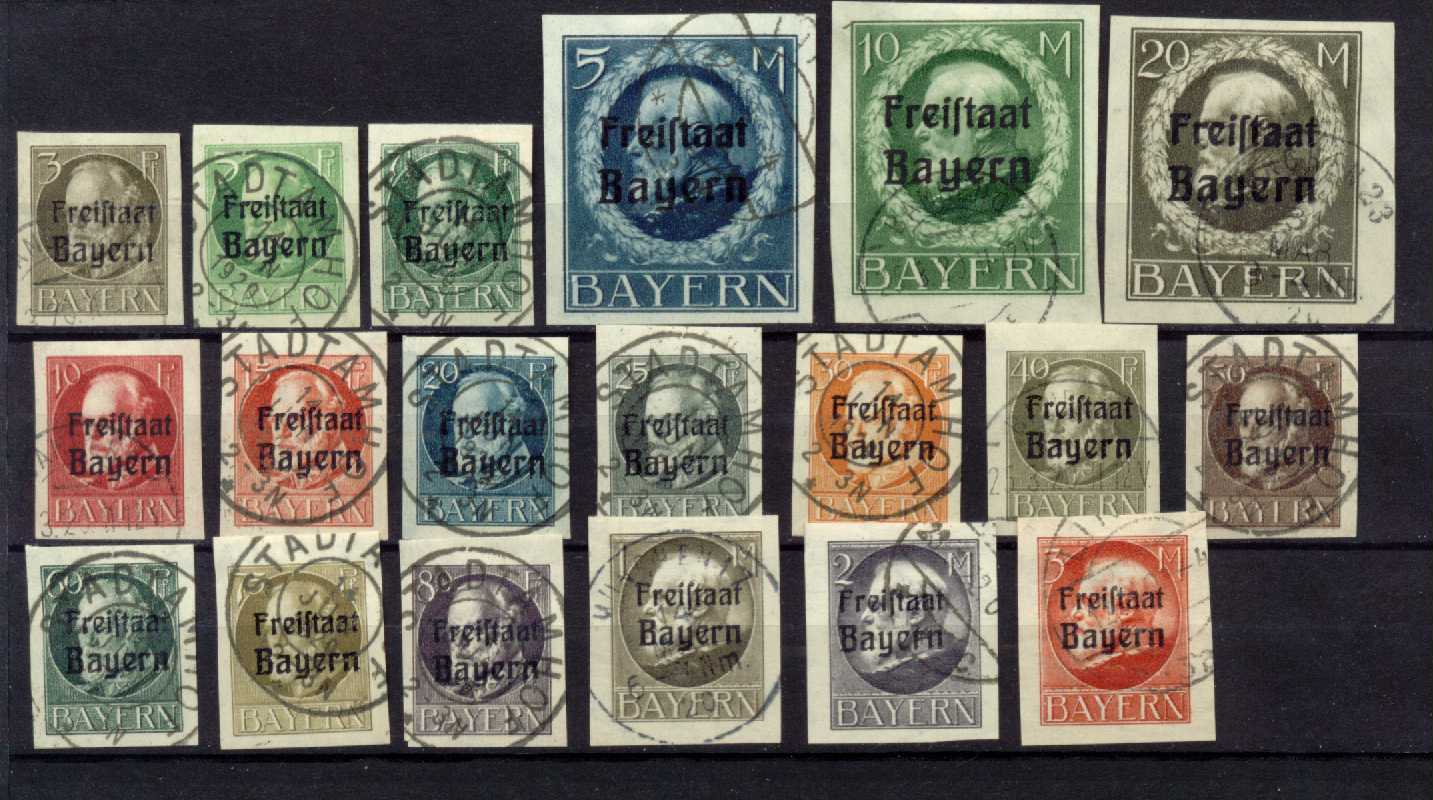
Some forgeries were made by Great Britain during World War I of the unoveprinted values 5 p, 10 p and 15 p (apparently to be used by spies). More information can be found at: http://www.psywarrior.com/BritishForgeriesWWI.html or in the book 'Postal Forgeries of the World' by H.G.L Fletcher. The design seems to have been copied very accurately (even the watermark). The perforation is different though, in the genuine stamps 14 holes can be found at the top perforation, in the forgeries 15 holes are found.
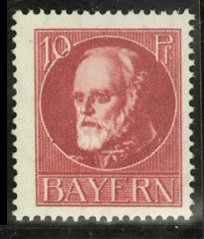
British intelligence forgery
Private labels with inscription 'HIRTH' or 'KRPR WILHELM' (= 'crown prince Wilhelm') instead of 'BAYERN' and 'FUR'S FLIEGERHEIM' at the bottom of the stamp exist. In the center a picture of several men:
I've also seen a 5 p brown with the image of
'PROF. SCHUTTE' in a similar design, as well as a 5 p brown with
'LILIENTHAL', a 5 p blue with 'PRINZ ADALBERT', a 5 p blue with
'PRINZ AUGUST WILHELM', a 5 p olive with 'WEDDIGEN', a 5 p violet
with 'LOCHOW', a 5 p violet with 'LUDWIG' and a 5 p violet with
'CARL FRANZ JOSEPH'.
I've also seen two sheets with 10 of these stamps (two rows of
five), all 5 pf violet with the portraits of 'HEINRICH',
'FALKENHAYN', 'HAESELER', 'GOLTZ', 'BISSING', 'TIRPITZ',
'HOLZENDORF', 'LIMAN N SANDERS', 'LOCHOW' and 'DANKE' on the
first sheet and 'FRANZ JOSEPH', LUDWIG', '?', 'ERZH FRIEDRICH',
'?', 'MOHAMED V', 'AUGUST', 'GROSSHERZOG FRIEDRICH', 'CARL FRANZ
JOSEPH' and 'ENVER' on the second sheet.